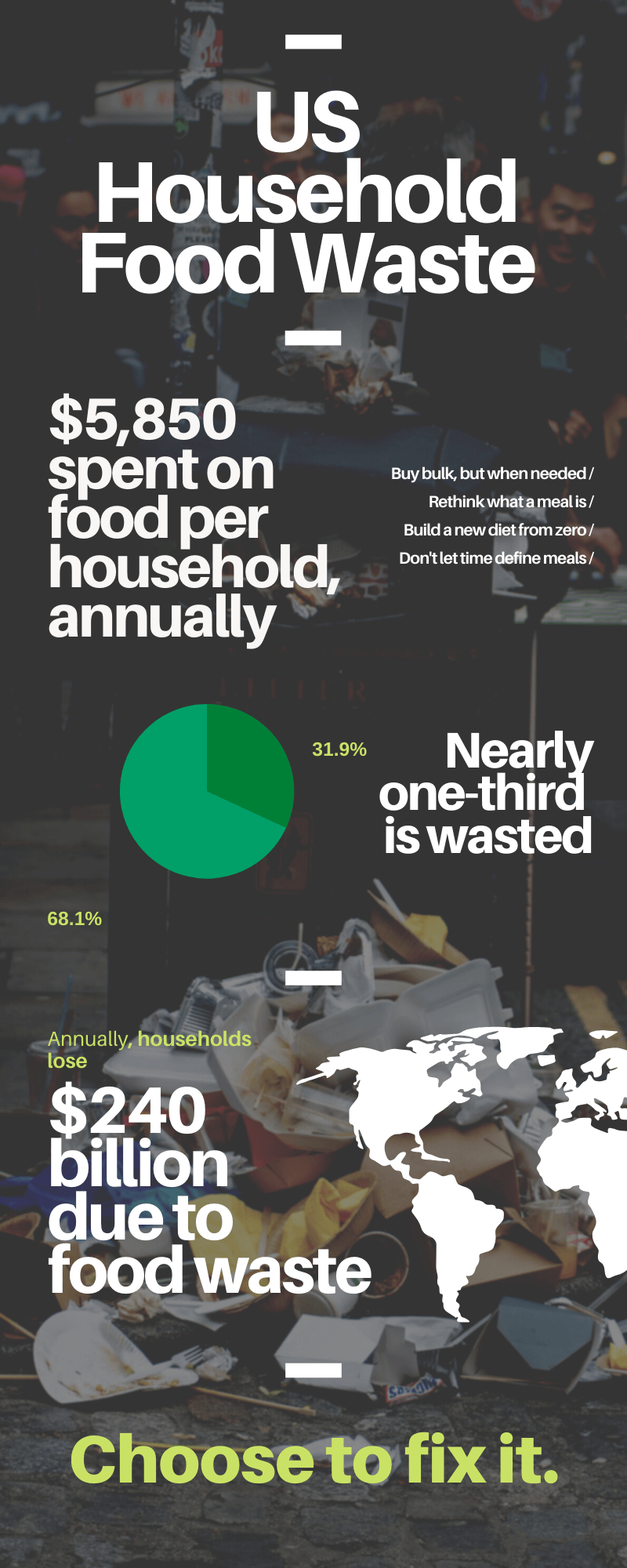A decade ago, Jenni and I were settling into our career paths, just out of university. As two 20-somethings we watched our food bills rise and thought little of the food waste produced. It was just one of the growing sources of money-sapping lifestyle inflation we had. We were adding convenience foods, eating out, and generally doing what people do once they're out of school and starting careers: spend! As our budget ballooned, so too did our carbon footprint and waste.
But what if we could rethink our relationship with food in a way that would cut waste and save money?
Food and Individual Empowerment
Many ideas about resilience and sustainability are nuanced, distant concepts. We don't personally have much direct control over them. But, there is something we all individually do that has a real effect on the environment, society, and even our own wealth. We eat, and sometimes without great efficiency.
It's been close to a decade since we started looking — bleary-eyed with student loan debt — at our finances and the consumerism that blew holes in our budget. We've been fortunate to turn the tide, and then some, through lots of small purchasing decisions along the way.
While writing about our journey towards financial independence, my partner and I spent copious amounts of time researching how to reduce our grocery expenses. Reducing food waste became a central theme of our expert guide to saving money at the grocery store.
Ultimately, we cut our monthly grocery expenses from $575.80 to $339.85 in 2019 — a more than 40% savings.
In the process, we found the fortunate side effect of a reduced carbon footprint and a dramatic drop in food waste. You might have the same outcome if you adopt some of the strategies that worked for us. Cutting food waste isn't just good for your pocketbook, it is better for our society and the environment.
Reducing Food Waste Can Save You Money

When food is wasted, so too are the resources used to produce that food.
An average U.S. household spends about $5,850 per year on food, according to the AAEA.
Reducing waste is an opportunity for households to directly improve the environment and strengthen their own financial position. While landfills are overflowing with wasted nutrition, food banks run out of resources to provide for those in need. In the time of a global pandemic, those most vulnerable tend to be those most in need of resources like food banks.
Food Waste in the United States
The average US household wastes 31.9% of the food it purchases. Consumer‐level food waste was valued at $240 billion in a single year. According to a Penn State study, the average US household loses $1,866 on wasted food per year (including a household's groceries, restaurants, and fast food).
The Money You Might be Wasting in Food You Throwaway
Penn State's study is based on US households, which the Census defines as 2.5 people. That means there's $746.40 per person, per year or $62.20 per month in wasted food for just one person! Cutting your personal food waste in half could put enough money into your budget for your Netflix subscription and cell phone bill combined. Not to mention all the knock-on effects to the environment.
5 Ways to Reduce Food Waste and Save Money
It's easy to say we can reduce our food waste to help the environment and ourselves. But what actual steps can we take to make this change? Here are some steps we used to help cut our food waste and save money:
1. Rethink what a meal is
If you’re like me, you grew up with a dinner plate that was nicely divided between three sections. It was a little pie chart of meat, a “starch”, and hopefully a vegetable. Eggs were for breakfast. Cereal was a complete meal. Sandwiches with cold cuts were for lunch.
You don't have to stick to the eating habits you learned as a child. Homo sapiens haven't adhered to the "eggs for breakfast, sandwich for lunch" diet for more than 99% of our species' existence. Your goal should be to satiate yourself and provide adequate nutrition at a reasonable cost.
2. Rethink your diet from zero
That doesn’t mean you need to switch to a diet of rice and beans. But, it does mean you should rethink your diet: start from the ground up rather than trying to remove things from your current diet. Consciously add dishes that meet nutritional requirements along with foods you enjoy and figure out how they can fit into your meal plan.
If you aren't a picky eater, identify the healthiest ingredients at the lowest cost, stick them in a blender, and create a meal. Kale and peanut butter in a smoothie? Have you tried it?
We don't have to eat all of our meals with a fork.
3. Don't let time be the master of your meals
You can eat dinner things for breakfast. Leftover beans from last night's dinner? Mix them in with your eggs. Just because you don't normally eat green beans with your breakfast doesn't mean you can't.
If you've run out of your typical breakfast foods, don’t force yourself to run out and restock the eggs just because they’re the normal accompaniment. Challenge yourself to incorporate the beans with breakfast instead. You’ll help prevent your leftover food from going to waste and make possibly expand your palate and find something new.
Having flexibility in your diet (and your definition of a meal) can lead to food efficiencies and a reduction in waste. This flexibility will also save you money.
4. Don't buy bulk when you don't eat in bulk
There are just two people in our household. We’re decidedly averaged sized, too. We often purchased the “family-sized” multi-packs of oatmeal because for years we've followed those repetitive “10 grocery tips to save money!” type of articles. They typically include:
- Buy in bulk
- Pay the lowest per unit/ounce price
That’s great advice when you're starting on a path towards saving money on groceries. But, if you're not in a four-person household, bulk buying might be more expensive. We’ve followed that bulk-buying advice and wound up with more than our fair share of big-bottle condiments sitting in the bottom fridge shelf slowly changing colors.
I thought ketchup was supposed to be a brighter red?
Here’s the advice when you're concerned about your food budget and waste: buy what you need!
Put that optimizing part of your brain to work on figuring out how much of the product you actually use over time. Purchase the size that’ll be consumed before it begins to crawl out of the fridge on its own.
Reduce waste, save money.
5. Grocery price-shop online; avoid driving
Most grocery stores have their in-store pricing available online either through their website or app. If the brand itself doesn’t, you might find prices by using contracted shopper services like Instacart (though their prices tend to be marked up a bit). This also lets you compare pricing with online grocers like Amazon or Boxed from the comfort of your home.
If you want to get the absolute lowest price for your grocery list and are willing to make multiple trips to do it, do your price comparisons online.
In our experience, it's not worth it to go to multiple locations (especially when a car is involved) to save a few extra dollars.
Save Money and Improve the Environment by Reducing Food Waste
Altering your perceptions of what a meal can be, when to have it, and not giving into marketing hype will let you rethink what food means to you. Using the tactics outlined in this article, along with a few extras focused on reducing costs, let us save over 40% on our monthly grocery budget while eating a healthful diet.
A pleasant side effect has been a much lighter trash bag with barely any food waste in sight. It's taken us some time, but our grocery spending reduction has lead to more efficient use of resources and a small improvement to the environment we had full control over.
You have the ability to make the same changes as we did, today. You can add to your wealth while taking less from the world around you.
What do you intend to do to help solve food waste in America? Reach out to Island Press & TicTocLife on Twitter with your ideas!


